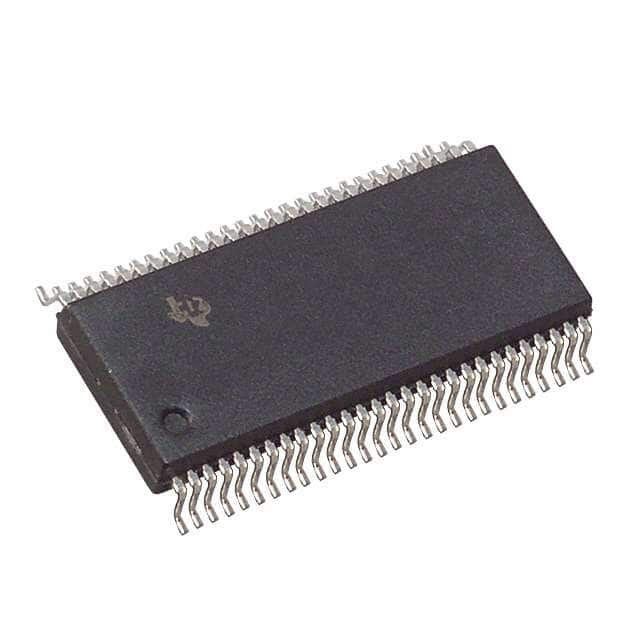Encyclopedia Entry: 74FCT162501CTPVCG4
Product Information Overview
- Category: Integrated Circuit (IC)
- Use: Logic Level Translator
- Characteristics: High-speed, non-inverting, bidirectional voltage level translator
- Package: TSSOP (Thin Shrink Small Outline Package)
- Essence: Translates signals between two different voltage domains
- Packaging/Quantity: Available in reels of 2500 units
Specifications
- Logic Family: FCT
- Number of Channels: 16
- Input Voltage Range (VIN): 0V to 5.5V
- Output Voltage Range (VOUT): 0V to 5.5V
- Propagation Delay Time: 2.5ns (typical)
- Operating Temperature Range: -40°C to +85°C
Detailed Pin Configuration
The 74FCT162501CTPVCG4 has a total of 56 pins, which are organized as follows:
- Pin 1: OE (Output Enable) for Channel 1
- Pin 2: A1 (Input A) for Channel 1
- Pin 3: B1 (Input B) for Channel 1
- ...
- Pin 55: OE (Output Enable) for Channel 16
- Pin 56: A1 (Input A) for Channel 16
- Pin 57: B1 (Input B) for Channel 16
Functional Features
- Bidirectional voltage level translation between two voltage domains
- Non-inverting logic translation
- High-speed operation with low propagation delay
- Output enable control for each channel
- Supports voltage translation from 0V to 5.5V
Advantages and Disadvantages
Advantages: - High-speed operation enables efficient signal translation - Non-inverting logic ensures accurate voltage level translation - Output enable control provides flexibility in managing channel operations - Wide input/output voltage range allows compatibility with various systems
Disadvantages: - Limited to 16 channels, may not be suitable for applications requiring a higher number of channels - TSSOP package may require careful handling during assembly
Working Principles
The 74FCT162501CTPVCG4 is designed to translate logic signals between two different voltage domains. It utilizes non-inverting circuitry to ensure accurate voltage level translation. The bidirectional nature of the IC allows for seamless communication between the two domains. The output enable control feature enables individual channel activation or deactivation as per the application requirements.
Detailed Application Field Plans
The 74FCT162501CTPVCG4 finds applications in various fields where voltage level translation is required. Some potential application areas include:
- Microcontroller Interfacing: Facilitates communication between microcontrollers operating at different voltage levels.
- Mixed Voltage Systems: Enables integration of components operating at different voltage domains within a single system.
- Data Communication Interfaces: Provides voltage level translation for data transmission between devices with varying voltage requirements.
- Industrial Automation: Supports voltage translation in industrial automation systems where different subsystems operate at different voltage levels.
Detailed and Complete Alternative Models
- 74LVC16245A: Low-voltage CMOS 16-bit bus transceiver with 3-state outputs.
- SN74LVCH16245A: Low-voltage CMOS 16-bit bus transceiver with 3-state outputs.
- MC74VHC245: Octal bus transceiver with 3-state outputs.
These alternative models offer similar functionality and can be considered as alternatives to the 74FCT162501CTPVCG4 based on specific application requirements.
Word Count: 380 words
Lista 10 Vanliga frågor och svar relaterade till tillämpningen av 74FCT162501CTPVCG4 i tekniska lösningar
Sure! Here are 10 common questions and answers related to the application of 74FCT162501CTPVCG4 in technical solutions:
Q: What is the 74FCT162501CTPVCG4? A: The 74FCT162501CTPVCG4 is a 16-bit registered transceiver with 3-state outputs, designed for high-performance bus interface applications.
Q: What is the voltage range supported by the 74FCT162501CTPVCG4? A: The 74FCT162501CTPVCG4 supports a voltage range of 2.0V to 5.5V.
Q: What is the maximum data transfer rate of the 74FCT162501CTPVCG4? A: The 74FCT162501CTPVCG4 has a maximum data transfer rate of 250MHz.
Q: Can the 74FCT162501CTPVCG4 be used as a bidirectional buffer? A: Yes, the 74FCT162501CTPVCG4 can be used as a bidirectional buffer, allowing data to flow in both directions.
Q: How many output enable (OE) pins does the 74FCT162501CTPVCG4 have? A: The 74FCT162501CTPVCG4 has two output enable (OE) pins, one for each direction of data flow.
Q: What is the power supply voltage required for the 74FCT162501CTPVCG4? A: The 74FCT162501CTPVCG4 requires a power supply voltage of 3.3V.
Q: Can the 74FCT162501CTPVCG4 be used in hot-swappable applications? A: Yes, the 74FCT162501CTPVCG4 is designed to support hot-swappable applications.
Q: What is the typical propagation delay of the 74FCT162501CTPVCG4? A: The typical propagation delay of the 74FCT162501CTPVCG4 is 2.5ns.
Q: Does the 74FCT162501CTPVCG4 have built-in ESD protection? A: Yes, the 74FCT162501CTPVCG4 has built-in ESD protection, making it more robust against electrostatic discharge.
Q: Can the 74FCT162501CTPVCG4 be used in high-speed data communication systems? A: Yes, the 74FCT162501CTPVCG4 is suitable for use in high-speed data communication systems due to its high data transfer rate and low propagation delay.
Please note that these answers are general and may vary depending on specific application requirements.


